10 Things to Do in Lisbon at Night
When night falls on Lisbon, the streets of its most popular neighbourhoods come alive with atmosphere, and its viewpoints and monuments reveal a different side thanks to their beautiful lighting.
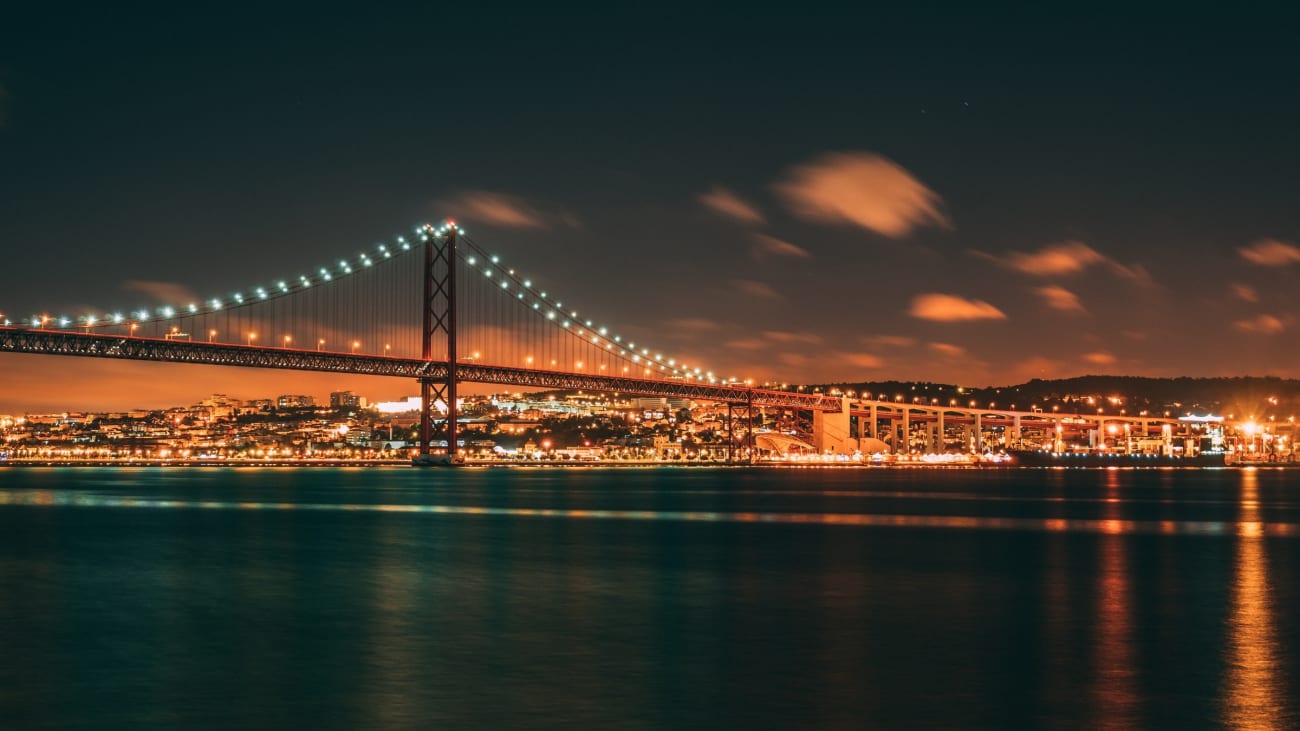
25th of April Bridge, Lisbon | ©Fulvio Ambrosanio
When researching what to do in Lisbon, don't overlook Lisbon's nightlife. The Portuguese capital has always boasted a bohemian and bustling nightlife, especially in Cais do Sodré and Bairro Alto.
In addition to nightlife, the Portuguese capital also has other attractions once the sun has set. Its lighting gives it a special beauty, and strolling through its streets is one of the best activities you can do. In addition, several of its spectacular viewpoints offer unbeatable views at this time of day.
1. Don't miss the sunset from São Jorge Castle
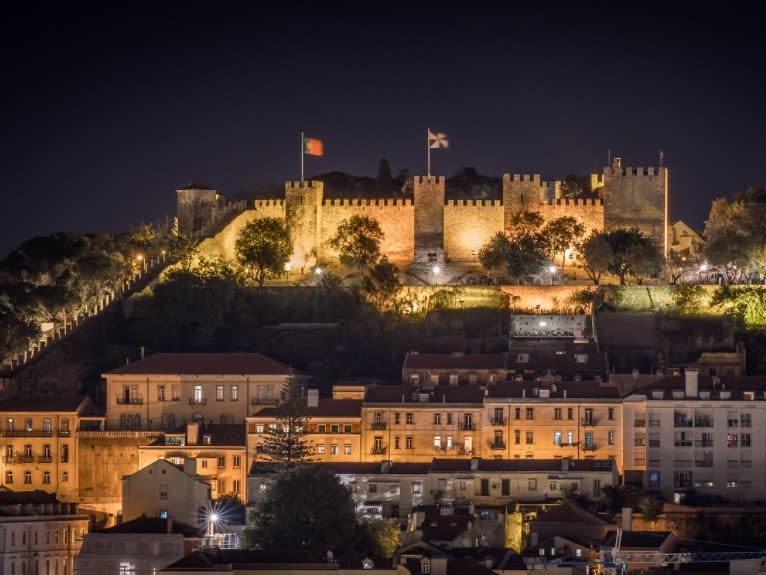
Although you have almost certainly arrived on a tour of the São Jorge and Alfama neighbourhoods or on your own, if you have the opportunity, I recommend that you visit later in the day to admire the views from its viewpoint as the sun sets.
Originally, it was the Romans who built this castle, but it was later completely rebuilt by the Visigoths and Arabs. Its position, on top of a hill, means that its silhouette can be seen from almost the entire historic centre. And from the castle you can see much of Lisbon and the Tagus River estuary, a view that becomes even more magical when night falls.
Practical information
- How to get there: the quickest way is to take the castle lift from Baixa de Lisboa. Another way, besides walking, is to take tram 28 to the Miradouro de Santa Lucía stop and walk to the castle from there.
- Opening hours: in winter from 9 a.m. to 6 p.m. and in spring and summer it closes at 9 p.m.
- Tickets: Adults pay around €10 and children go free.
2. Listen to fado while you dine
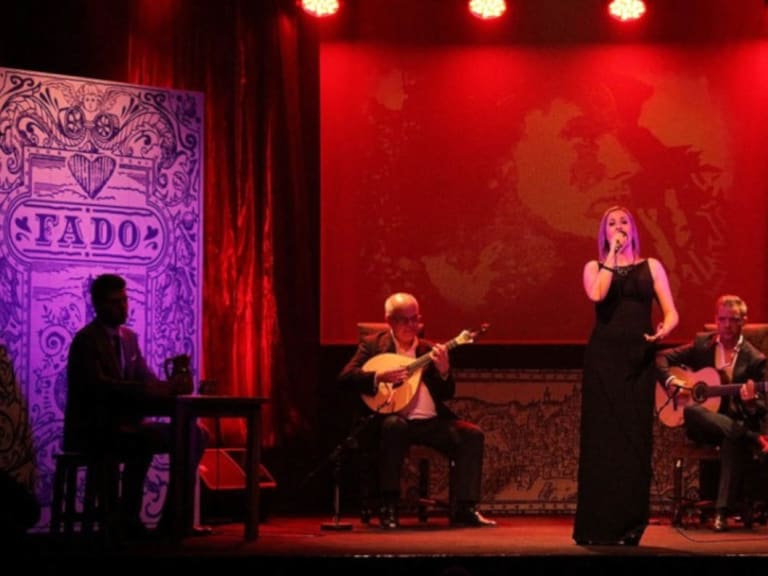
If you are spending more than a day in Lisbon, you cannot miss a fado show, the most typical musical genre in the whole country. Even if you know nothing about this type of music, I assure you that you will enjoy the evening. You have several options:
Fado has been recognised by UNESCO as Intangible Cultural Heritage of Humanity and is a true symbol of Portuguese popular culture, born in the humblest neighbourhoods. This origin is reflected in the themes of the songs, which are generally marked by nostalgia and a certain sense of frustration.
As I explain in my article on the best places to dine while listening to fado, the Alfama neighbourhood is home to a large number of restaurants where you can enjoy a good meal while singers perform various songs. Even so, here are several options:
- Tickets for a fado concert in Lisbon, from CAD 34
- Fado tour in Lisbon with dinner, from CAD 80
- Private fado tour in Lisbon with dinner, from CAD 213
3. Sign up for a sunset sailing trip on the Tagus

If you book a sailing trip on the Tagus, you will enjoy one of the best cruises in Lisbon. Although this trip starts in the afternoon, watching the sunset from a sailing boat makes it an incredible experience for any visitor.
For around two hours, you will sail along part of the Tagus River to see some of Lisbon's most important monuments from the water, from the Belém Tower to the Jerónimos Monastery, passing under the 25 de Abril Bridge.
The best moment of this river trip comes when the light begins to change colour as dusk falls with the city in the background. When the sun sets, the boat returns to dry land so you can continue visiting Lisbon.
4. Explore the old Alfama neighbourhood
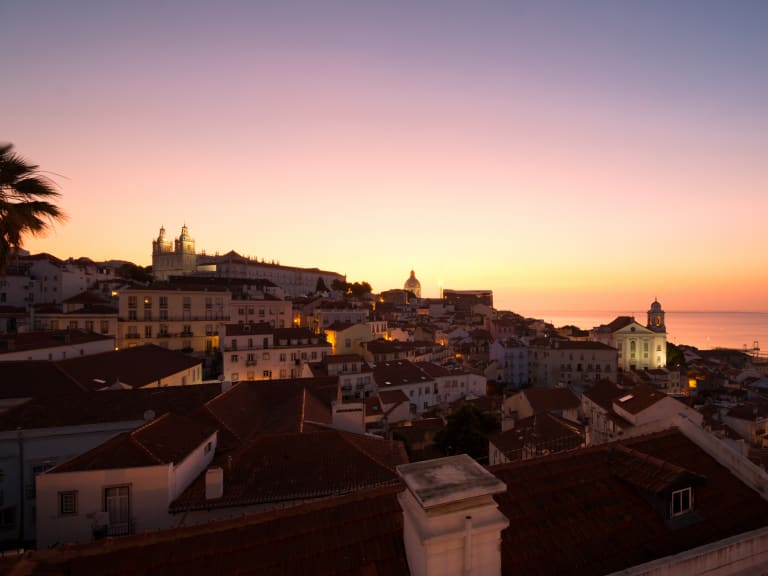
While a visit to the Alfama neighbourhood is always interesting, when the sun begins to set, the tour can be even more fascinating. In recent years, the entire area has been revitalised and today it is bustling with atmosphere and full of places to eat.
With the lights now on, the streets of the neighbourhood regain some of their old, almost roguish atmosphere, so to speak. Walking through its steep, narrow streets on a guided tour of Alfama, you can reach some spectacular viewpoints where you can spend a pleasant time:
- Mirador de Santa Lucía: it retains a typical Lisbon look, with a mixture of romanticism and a certain decadent air.
- Gracia Viewpoint: located near St. George's Castle, this viewpoint has become a favourite among Lisbon's youth when night falls.
- Portas do Sol Viewpoint: very popular with tourists, this viewpoint has not lost the essence of the Alfama neighbourhood. The panoramic view is simply breathtaking, with the church of Sao Vicente de Fora flanked by pastel-coloured houses and the Tagus River in the background.
5. Join the strollers in Praça do Comércio

Praça do Comércio is one of the nerve centres of Lisbon and the starting point for some interesting tourist bus tours. At night, in addition to the atmosphere there, it is essential to walk around and go to the banks of the Tagus to see the illuminated Arco da Rua Augusta and, in the distance, the silhouette of the 25 de Abril Bridge.
In this area, you will find many restaurants and ice cream parlours, as well as one of the most famous cafés in the city: A Brasileira, located in one of the streets surrounding the square, in a historic Art Deco building.
According to reports, it was the first café in Lisbon to serve bica, a small cup of very strong coffee. It was also the venue for gatherings attended by great intellectuals such as Fernando Pessoa. Don't hesitate, book your tourist bus tour of Lisbon and finish at A Brasileira.
6. Take a night tour of the Belém neighbourhood to see its illuminated tower

Visits to the Belém neighbourhood are usually made in the morning, when there are quite a few people seeing its main attractions at the same time. A good idea to avoid these crowds is to book a guided tour of Belém in the afternoon and extend the tour until its impressive monuments are lit up.
I recommend that you include it in the list of organised excursions in Lisbon. The two most attractive places in the neighbourhood are the Jerónimos Monastery and the Belém Tower, closely followed by the Monument to the Discoveries.
If you can stay until nightfall, I recommend you don't miss the illuminated tower. With a little skill, you'll get one of the best photographs of your trip.
7. Mercado da Ribeira (Time Out Market), a good option for dinner

A great way to start the evening in Lisbon is to grab a bite to eat at Mercado da Ribeira, specifically at Time Out Market. This market is the most popular in the city, mainly because of its wide selection of fresh fish.
A few years ago, the building was remodelled and partly occupied by a large number of food stalls, terraces and venues where cultural events are held. The Time Out Market, as this space is now called, is located in one of the trendiest areas, Cais do Sodré, very close to the centre. At its stalls, you will find many typical Portuguese dishes.
I recommend trying one of the cod specialities served at the stalls and, if possible, accompanying your meal with a good Portuguese wine. For dessert, there are several places serving freshly made pastéis de Belém. Another option for immersing yourself in the culinary culture is to book a gastronomic tour of Lisbon.
8. Experience Lisbon's nightlife

Those who want to enjoy a night out during their stay in Lisbon are in luck. There is plenty of nightlife and it is easy to find places to suit all tastes. If you want to get around easily between the different areas, I recommend booking the Lisboa Card.
The areas with the most bars and nightclubs are in Bairro Alto, Chiado and Cais do Sodré.
- Bairro Alto: in its streets you will find a large number of venues of all kinds. If you prefer a quiet place, you can opt for the terraces of Largo de Camoes or the area around the Sao Pedro de Alcantara viewpoint. For a livelier, student atmosphere, it is better to go to one of the bars with live music or the nightclubs in the neighbourhood.
- Cais de Sodré: the atmosphere in this area tends to be a little quieter than in Bairro Alto. However, there is no shortage of clubs and discos playing everything from rock to African music.
- Santa Apolónia/Jardim do Tabaco: coming down from Alfama, you will find an area with several restaurants, as well as some of the city's most popular nightclubs. In Santa Apolónia, you can try to get into Lux, a nightclub that usually ranks among the top clubs of its kind in Europe.
9. Cultural life in Lisbon
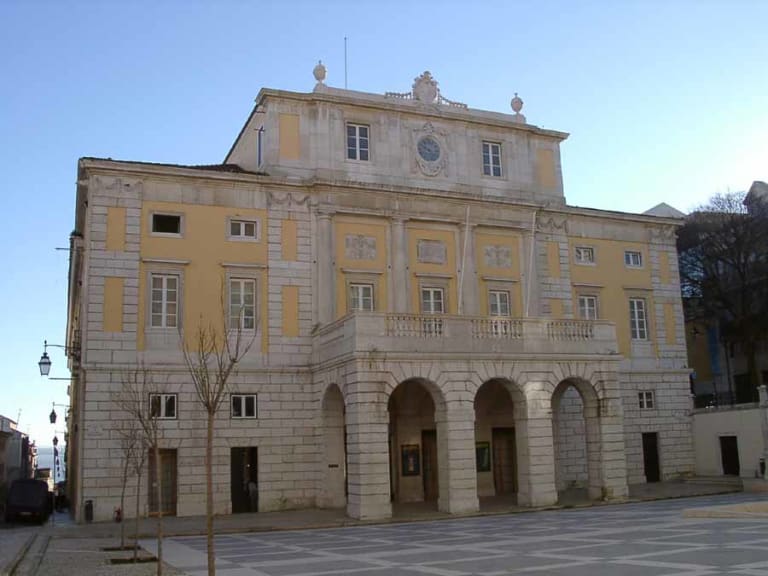
If you are spending more than a day in Lisbon, you have to explore Lisbon's nightlife, which is full of cultural events, especially concerts, theatre performances and dance. If you want to get to know the cultural life of the city, you should try to visit one of its theatres or auditoriums.
The Portuguese capital has several theatres: Sao Carlos and Dona Maria are historic buildings with architecture that is worth a visit, even if you don't go in to see the plays. Both theatres offer a good range of theatre. Their performance calendar mixes Portuguese plays with those by international authors. Although the performances are in Portuguese, the experience is very interesting.
If you prefer another artistic genre, perhaps the most recommended in the Portuguese capital is dance. The best place is undoubtedly the Camões Theatre, home to the National Dance Company. The venue is located in the so-called Park of Nations, very close to the Atlantic Pavilion (where many concerts are held) and the Lisbon Casino.
10. Take the Santa Justa lift
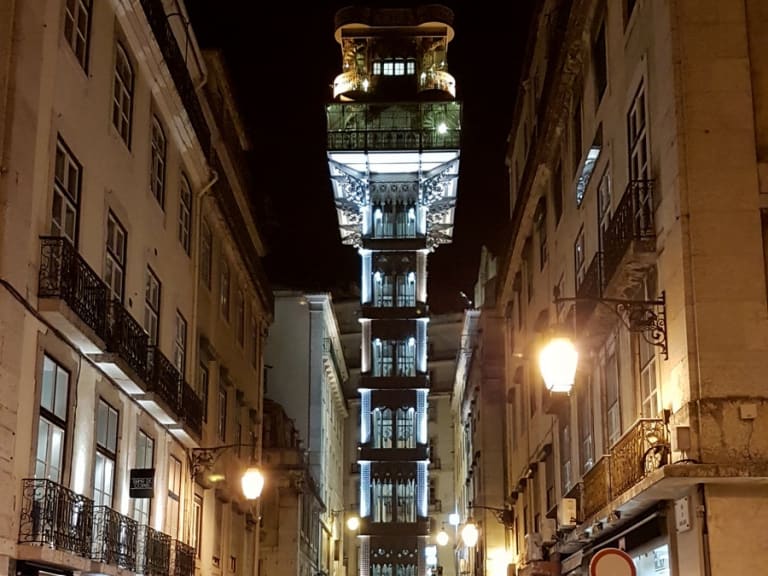
On the way to the Bairro Alto, you will come across a strange iron structure that seems to appear out of nowhere. This is the Santa Justa Lift, which connects Baixa with the Chiado neighbourhood. It is one of the things you have to see and do in Lisbon, and I recommend you go up just before dusk.
This elevator was built in a neo-Gothic style, with obvious inspiration from other iron constructions such as the Eiffel Tower. After travelling up its 45 metres, you reach a large terrace offering wonderful views of the river, Baixa, Rossio Square and São Jorge Castle.
There is a café on the terrace if you want to have a drink while enjoying the views. Bear in mind that there may be queues to use the lift in the afternoon, as many people want to watch the sunset and the night-time lights come on from above. And if you feel peckish after the climb, it may be the ideal time to book a gastronomic tour of Lisbon.
Practical information
- Opening hours: 7:30 a.m. to 9 p.m. (November-April) and 7:30 a.m. to 11 p.m. (May-October).
- Price: approximately £4.50 return, including admission to the viewpoint.
Where to stay in Lisbon?
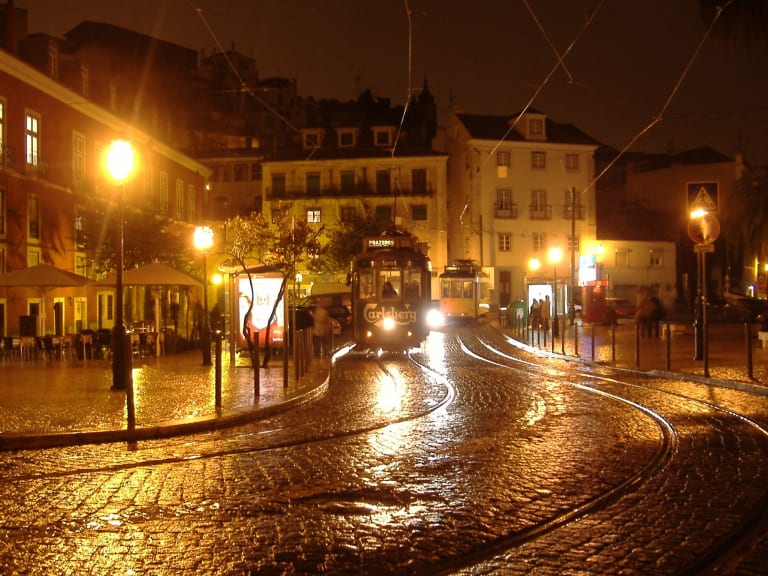
When choosing accommodation for a trip, there are always various factors to consider, such as the area you prefer to stay in and your budget. The Portuguese capital has a wide range of hotels, as well as many apartments.
One tip to keep in mind is that if you are travelling in summer, which is high season, you should book your room well in advance. As for areas, here are some recommendations:
- Alfama: the Alfama neighbourhood has become a favourite among many tourists looking for accommodation. Its charm and the large number of apartments on offer are definite pluses. On the downside, you may encounter transport problems when trying to get to your hotel.
- Praça do Comércio: around this square you will find several interesting hotels, although the prices are somewhat higher. Transport links to the airport and other areas of the city are quite good.
- Near Avenida da Liberdade: in the area surrounding this avenue, between Praça do Comércio and Rossio, you will also find several interesting places to stay.
- Baixa: this area stretches from Rossio to Praça do Comércio and is notable for its wide range of hostels and hotels. It is also close to most of the city's attractions.
- Chiado and Bairro Alto: the advantage of staying in these neighbourhoods is the presence of numerous shops, historic cafés and the best of the city's nightlife. However, the noise in some streets can be annoying.
How to get around the city at night

During the day, the tram is undoubtedly the best way to get around the most popular tourist spots, especially the well-known ones:
- Line 28: runs through the entire historic centre and passes by almost all of the city's must-see monuments.
- Line 15: this is the perfect option if you want to visit the Belém neighbourhood on your own, as it goes to the western part of the capital.
The main problem with these lines is that you will hardly be able to use them at night. Tram 28 stops running at 9:15 pm on weekdays and at 10:30 pm on Saturdays and Sundays. Line 15, on the other hand, gives you a little more leeway: Monday to Saturday it runs from 5:45 a.m. to 1:00 a.m. and Sundays and public holidays from 6:05 a.m. to 1:00 a. m.
As for city buses, they are more useful at night, as there are several lines that start running around 11:45 p.m. There are two types of night bus: the Rede da Madrugada and the Night Buses. They are free and only run at weekends. Also, bear in mind that with the Lisboa Card you can save time and money when visiting and getting around the city.
